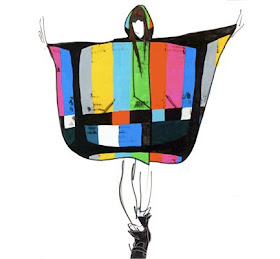
Stephen Sprouse, Debbie Harry Green Dress Polaroid
The Influence of Art Tastemakers on Fashion, Stephen Sprouse: According to Caroline Cox, Sprouse acknowledged “the clichés of youthful rebellion [and] toyed with items of subcultural style, which through overuse in popular imagery became mainstream.” Through his design he was able to reach many different target audiences with the help of his industry connections to fame. He also “contributed to the longevity of the punk style,” and but brought an edge to the concept of punk.

UK Vogue on Sprouse
Later in his life he did collaborations with Louis Vuitton (higher end), and Target (lower end, where he did a patriotic line). But what seemed very important was having culturally influential friends who helped to get his name known. Sprouse was introduced to Andy Warhol and the Factory which heightened his career to a different level. Warhol can be considered a tastemaker, having an influence on a level similar to such institutions as the MoMa due to his ability to influence popular culture and taste of the mainstream sensibility. Although museums had been able to dictate what was ‘fashionable’ or considered tasteful for years, a new breed of tastemakers was born in post-modern New York. The artists were having more of a say due to the cultural changes going on in the city at the time.
Stephen Sprouse happened to be one of the many talented people that Warhol chose to hang around. There was a scene surrounding Warhol, and trends were set in popular culture based on who Warhol was seen with, and what he was doing both in life and art. As Elizabeth Currid said, “the art and culture scene still congregated in nightlife, though it became less about performance and actual artistic production, and more about the networking and the exchange of knowledge necessary to establishing oneself in the field.”

Stephen Sprouse, TV Sketch
Sprouse was able to use Warhol’s old Factory space, which acted as a platform for the display of his clothing. The factory space, which in the past was used as a place for art creation and display, now had a new context and meaning when switched from an art context to a fashion context. Fashion and art were becoming more and more synonymous with the scene of New York in the late 80’s. Culture was more importantly becoming a part of the fashion industry. With this phenomenon appearing, “nation and international publicity was directed at artists in a manner that illustrates the distorted values of the culture industry.
Sprouse’s ability to dabble in both art and fashion collaborations was also one of his greatest assets. Although his business strategy was not the strongest, he managed to always keep a positive reputation, whether his style was out at the moment or not. His later collaborations with Louis Vuitton are still highly sought after, especially after his death from heart failure in 2004.

Stephen Sprouse, Iggy on the Cross
Sprouse was an example of the result of tastemakers dictating what is fashionable. He was supported by magazines, huge clothing chains (Bergdorf’s, Bendel’s, etc), and by the many iconic and influential artists he worked with. It is these collaborations that will keep both of these worlds running in the future.

No comments:
Post a Comment